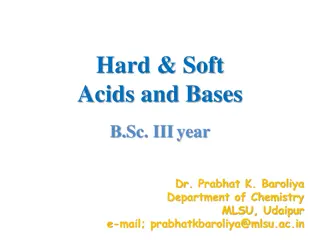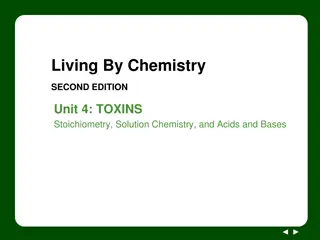Understanding Conjugate Acids and Bases in Chemistry
Explore the concept of conjugate acids and bases in chemistry through definitions, reactions, and examples. Learn how to identify strong and weak acids/bases based on their conjugates and understand the behavior of acids/bases in reverse reactions. Discover the significance of conjugate acids/bases in determining the strength of acids and bases in chemical reactions.
Download Presentation

Please find below an Image/Link to download the presentation.
The content on the website is provided AS IS for your information and personal use only. It may not be sold, licensed, or shared on other websites without obtaining consent from the author. Download presentation by click this link. If you encounter any issues during the download, it is possible that the publisher has removed the file from their server.
E N D
Presentation Transcript
Conjugate acids and bases
Different definitions of acids and bases Arrhenius definition- acids generate H3O+ in water, bases generate OH-in water Br nsted Lowry definition-Acids are proton donors. Bases are proton acceptors which is an acid/base? HF + H2O H3O++ F- NaHCO3+ H2O Na++H2O + CO2+ OH- By Arrhenius, HF is an acid, is a NaHCO3 base.
Follow the proton HF + H2O H3O++ F- H+ H+ NaHCO3+ H2O Na++ H2O+CO2+OH- H+ H+ What about the reverse reaction?
Conjugate acids and bases When you run the reverse reaction you find the products are also acids and bases. The acids and bases that are formed are called conjugate acids or bases H2O + HF H3O+ + F- base acid conjugate acid conjugate base NaHCO3 + H2O Na+ +H2O + CO2 +OH- base acid CA CB
Label Acid, Base, Conjugate Acid, Conjugate Base HClO3 + H2O ClO3- +H3O+ A B CB CA ClO- + H2O HClO+OH- B A CA CB HSO4- + H2O SO42- +H3O+ A B CB CA LiOH + H2O Li+ + H2O+OH- B A CA CB
Conjugate acids and bases Conjugate acids and bases determine if an acid or base is strong or weak. If the conjugate acid/base readily reacts to run the reverse reaction it is a weak weak acid/base. If it does not react in the reverse reaction the acid or base is strong. strong.
More with conjugate acids/bases H2SO4 + H2O H3O+ + HSO4- Sulfuric acid is a strong acid so its conjugate base, HSO4-, will not run the reverse reaction. HSO4 - is actually an acid in water. HSO4 - + H2O H3O+ + SO42- SO42- will run the reverse reaction, so it is a weak acid
Strong acids and bases The strong acids and bases have no reverse reaction. They are not an equilibrium reaction. HCl + H2O H3O+ + + Cl- No amount of stress will force this reaction the other way. (no way to make it less acidic, without a different reaction)
Strong acids Acid Hydrochloric acid Hydrobromic acid Hydriodic acid formula HCl Acid Sulfuric Acid Nitric Acid Formula H2SO4 HBr HNO3 HI Perchloric Acid HClO4
Strong Bases these make a lightning bolt on the periodic table! Name Formula Name Formula Sodium Hydroxide Potassium Hydroxide All of group 1 is strong, NaOH Calcium Hydroxide Strontium Hydroxide Barium Hydroxide Ca(OH)2 KOH Sr(OH)2 But not commonly used! Ba(OH)2
Weak acids and bases can be forced the other way So ammonia NH3 + H2O NH4+ ++OH- Ammonia is a gas with a distinct odor Ammonium and hydroxide are both odorless. If base is added to the solution you will smell ammonia, if hydroxide is removed you won t smell anything.
Pet Stain Problem Urine has ammonia in it. Most cleansers are basic. After cleaning, we still leaves small amounts behind. If it is small amount of ammonia and a basic cleanser the equilibrium will be shifted to the ammonia side so some thing with a great sense of smell (dog) could pick it up. A slightly acidic cleanser shifts the equilibrium to the ammonium side to solve this problem
Other weak acids and bases Weak Acids Acetic Acid (vinegar) Citric Acid Ascorbic Acid (vitamin C) Boric Acid Carbonic Acid Weak Bases Sodium Bicarbonate Ammonia Sodium Hypochlorite (bleach)
Indicators Indicators are a substance that change color in the presence of (whatever they check for) They do this because of Le Ch telier s principle. All you need an equilibrium reaction with different colored products and reactants. The pen used to check for counterfeit money is a starch indicator
How an acid base indicator works A generic indicator will follow this A generic indicator will follow this reaction, reaction, HID HID is the reactant indicator, and is the reactant indicator, and ID ID- - is its product is its product [HID] [HID] + H + H2 2O O H H3 3O O+ + + The color differences are important, The color differences are important, HId one color and one color and Id Id- - is a different color! is a different color! in an acidic solution (high H in an acidic solution (high H3 3O O+ +) you see reactant reactant [HID] [HID] + H + H2 2O H H3 3O O+ + + in a basic solution (low H in a basic solution (low H3 3O O+ +) you see product product H H3 3O O+ + + + [ [ID] ID]- - HId is is ) you see O + [ [ID] ID]- - ) you see ID]- - + [ [ID] + H2 2O O H[ID] H[ID] + H
Acid Base indicators Acid base indicators change color at certain pH levels They don t have to change at 7 (most don t) Universal indicator solution (phenolphthalein, bromthymol blue and methyl red dissolved in ethanol and water) changes color at each integral pH value
Other pH indicators Litmus and phenolphthalein are indicators Red cabbage juice has a pigment that changes colors at different pH values
Buffers Buffers are solutions that don t change in pH when acids or bases are added. They use weak acids/bases and Le Ch telier s principle. You will have a large amount of weak acid and conjugate base WA = weak acid HWA + H2O H3O+ + + WA-
pH pH depends on the concentration of hydronium pH = -log [H3O+ +] ] Concentration of hydronium is Concentration of hydronium is the ratio of solute to solvent or the ratio of solute to solvent or in this case in this case H3O+ + / / H2O
What it does HWA + H2O H3O+ + + WA- adding H3O+ + forces the equation to SHIFT the left Which makes more water and removes some H3O+ +, so the [H3O+ +] remains constant
What it does HWA + H2O H3O+ + + WA- removing H3O+ + (adding OH-) forces the equation to SHIFT to the right Which make more H3O+ +, and removes some water removes some water so the [H3O+ +] remains constant There is a breaking point where the pH will change. , and
What does this have to do with my life? Your blood is a buffered solution The pH must remain between 7.35-7.45 Outside of that range can kill you below this range is called acidosis above is called alkalosis























